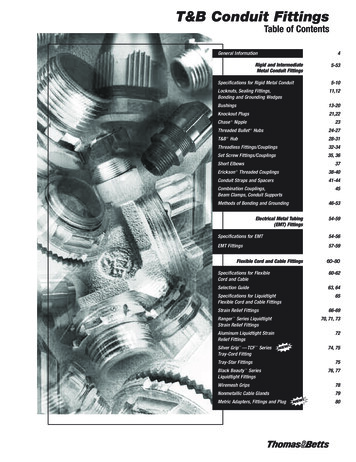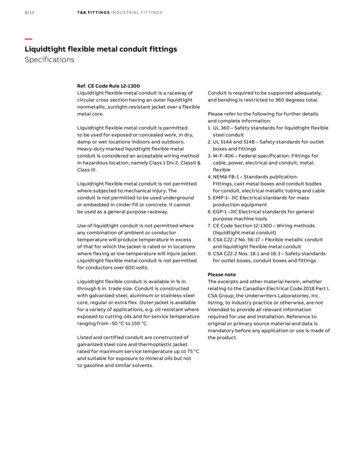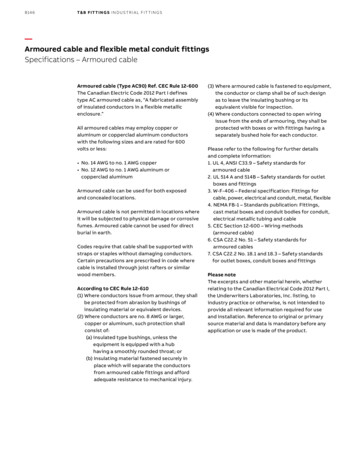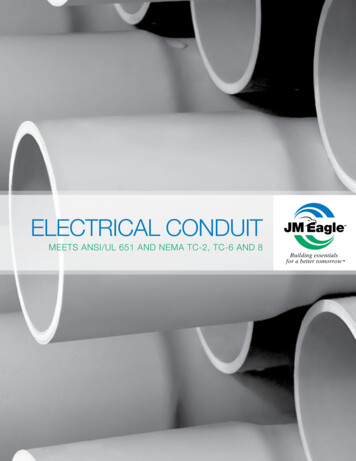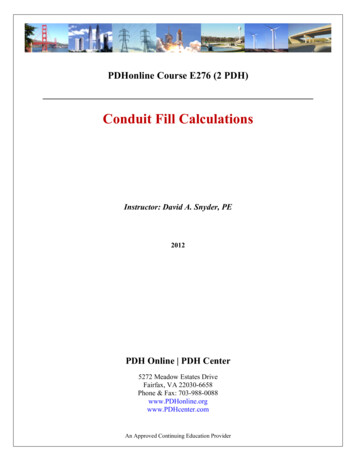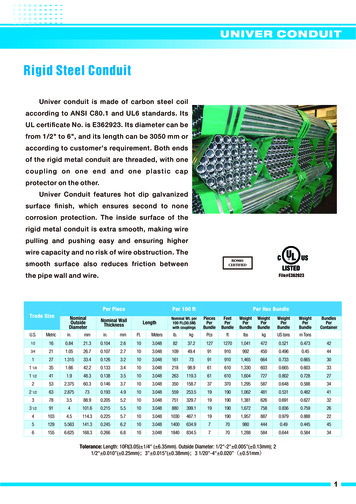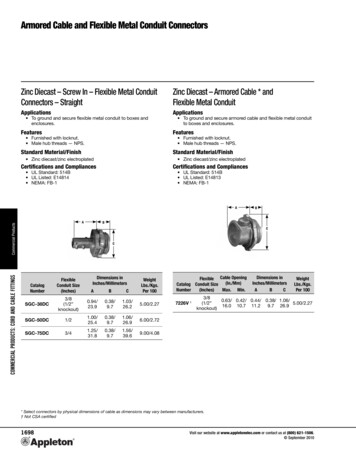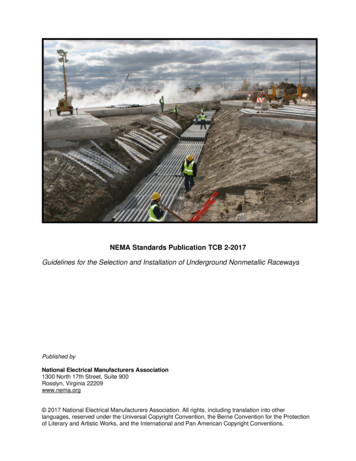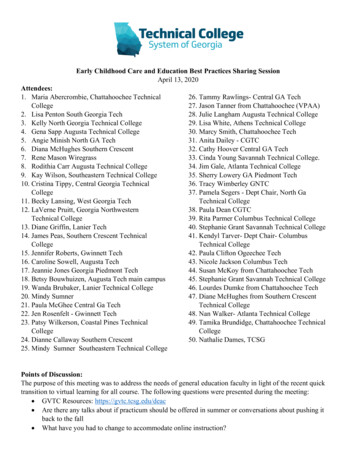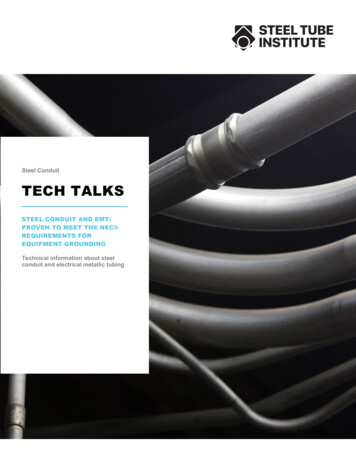
Transcription
Steel ConduitTECH TALKSSTEEL CONDUIT AND EMT:PROVEN TO MEET THE NEC REQUIREMENTS FOREQUIPMENT GROUNDINGTechnical information about steelconduit and electrical metallic tubing
In addition to system grounding, electrical systems require equipment grounding and bonding to safeguard personnel. Properly sized and bondedequipment grounding conductors ensure that all metal parts of electrical equipment are at the same electrical potential as the earth to preventelectric shock and provide a low impedance path to facilitate the operation of the circuit protective devices.The National Electrical Code (NEC ) recognizes several types of conductors that are permitted to be used as equipment grounding conductorsin Section 250.118. Rigid metal conduit, intermediate metal conduit and electrical metallic tubing are permitted in 250.118(2), (3) and (4)respectively, followed by other restricted uses of metal raceways, metal cable trays, and metal cables.Steel conduit and EMT are widely used in secondary power distribution systems, indoors and outdoors. Systems are designed in such a way thatthe steel conduit or EMT does not carry any appreciable electric current under normal operating conditions. Under certain fault conditions, thesteel conduit or EMT, acting as an equipment grounding conductor, will carry most of the return fault current, or, in some cases, it will be the onlyreturn path of the fault current to the source.NEC REQUIREMENTSNEC Article 250 contains the general requirements for grounding and bonding of electrical installations as well as other specific requirements.According to the 2008 NEC Handbook, “Sections 250.4(A) and (B) ’General Requirements for Grounding and Bonding’ set forth in detail whatmust be accomplished by the grounding and bonding of metal parts of the electrical system. The metal parts must form an effective lowimpedance path to ground in order to safely conduct any fault current and facilitate the operation of overcurrent devices protecting the enclosedcircuit conductors.”Part VI of Article 250 specifically covers equipment grounding. Part VI includes the list of allowable equipment grounding conductors in Section250.118, as noted above.In order for steel conduit and EMT to perform effectively as equipment grounding conductors, it is crucial that they are installed properly with tightjoints. If a fault occurs, this helps ensure a continuous, low impedance path back to the overcurrent protective device. If the joints are not madeup tight or if there is a break in the ground fault current path under fault conditions, there is a possibility of electric shock for anyone who comesin contact with the conduit. The NEC requires in Section 300.10 (Electrical Continuity) and in 300.12 (Mechanical Continuity) that “metalraceways, cable armor, and other metal enclosures for conductors shall be metallically joined together into a continuous electrical conductor andshall be connected to all boxes, fittings, and cabinets so as to provide effective electrical continuity.”“Equipment Grounding Conductor Installation” the NEC requires that all connections, joints and fittings “shall be made tight using suitable tools.”Section 250.122 covers the sizing of equipment grounding conductors and includes Table 250.122, Minimum Size Equipment GroundingConductors for Grounding Raceway and Equipment. This section makes it clear that the conductor sizes in Table 250.122 may not be adequateto comply with 250.4(A)(5), Effective Ground-Fault Current Path (Grounded Systems), and 250.4(B)(4), Path for Fault Current (UngroundedSystems), and may have to be evaluated to ensure that they can provide the effective ground path.The SOARES BOOK ON GROUNDING, published by IAEI, states that the “NEC does not dictate any particular size of conduit or tubing to serveas the equipment grounding conductor for an upstream overcurrent device. It is felt that the metallic raceway that is sized properly for theconductor fill will provide an adequate equipment ground fault return path.”In 1966, Eustace C. Soares, one of the most renowned experts in the area of grounding electrical systems, had published the first edition of hisbook, Grounding Electrical Distribution Systems for Safety, which included tables showing acceptable lengths of steel conduit and EMT forequipment grounding, based on his calculations. If field tests were performed, no evidence of it was ever discovered.In the early 1990s, U.S. steel conduit producers decided to undertake a research project in order to confirm the Soares Tables, to providescientific proof that steel conduit and EMT do provide an adequate equipment ground fault return path, and to provide software that would helpengineers determine the appropriate run lengths of steel conduit and EMT when used for equipment grounding.GEORGIA INSTITUTE OF TECHNOLOGY GROUNDING RESEARCHOne of the top experts in the field of grounding, Dr. Sakis Meliopoulos, professor of electrical and computer engineering at Georgia Tech, headedthe grounding research that was completed in 1994. This research represented the first update on the impedance and permeability of steelconduit in over 40 years.The National Electrical Code and NEC are registered trademarks of the National Fire Protection Association, Quincy, MA.Steel Tube Institute Tech Talks: Steel Conduit And EMT: Proven To Meet The NEC RequirementsFor Equipment Groundingsteeltubeinstitute.org2
The first phase of the grounding research at Georgia Tech consisted of resistance and permeability testing of various steel raceways that werepurchased from local distributors. Based on this information, Dr. Meliopoulos and his team developed a computer model and validated the resultsthrough actual field testing. The next step was to develop a computer software program that allowed the user to calculate the appropriate lengthof steel conduit or EMT runs necessary to meet NEC requirements.A few years later, Georgia Tech conducted research on steel conduit to show how steel conduit reduces electromagnetic fields. This researchwas added to the grounding research and was ultimately rolled into the GEMI (Grounding and ElectroMagnetic Interference) software analysisprogram, now available for free downloading at www.steeltubeinstitute.org.SUMMARY OF KEY FINDINGS IN GEORGIA TECH GROUNDING RESEARCHThe GEMI research project and resulting software analysis program proved that listed steel conduit and EMT clearly exceed the minimumequipment grounding requirements of the NEC. In addition, the GEMI research on grounding verified the following: Comparably sized steel rigid conduit, IMC and EMT allow the flow of higher fault current than an aluminum or copper equipmentgrounding conductor as listed in NEC 250.118. Steel rigid conduit, IMC and EMT provide a low impedance path to ground and facilitate the operation of the overcurrent devices in runsnot exceeding the maximum allowable lengths detailed in the research report. Where lengths do not exceed the maximum allowable computed by the GEMI software, supplemental grounding conductors insecondary power systems enclosed in steel EMT, IMC or rigid conduit do not add to safety in a phase to neutral fault. The use ofsupplementary equipment grounding conductors, when participating in the fault circuit, reduce the overall impedance and may or maynot increase the allowable length of the run, depending on the size and system design. The maximum allowable length for a specific system depends on conductor size, steel conduit size and fault type. In many cases, themaximum allowable length for a phase to neutral fault is shorter than the maximum allowable length for a phase to steel conduit fault.Thus, in most cases, the steel conduit is not the limiting factor in a conductor to neutral fault.FREE DOWNLOADS OF GEMI SOFTWAREThe GEMI software is available for free downloading at www.steeltubeinstitute.org. Click on “Resources” then “GEMI Analysis Research,” whereyou will also find copies of the two Georgia Tech research reports on grounding and on shielding against electromagnetic fields.Steel Tube Institute Tech Talks: Steel Conduit And EMT: Proven To Meet The NEC RequirementsFor Equipment Groundingsteeltubeinstitute.org3
This table shows examples of calculations from the GEMI (Grounding and ElectroMagnetic Interference)analysis software program.Steel Tube Institute Tech Talks: Steel Conduit And EMT: Proven To Meet The NEC RequirementsFor Equipment Groundingsteeltubeinstitute.org4
* 60 C for 30- and 30-ampere devicesThis table shows examples of calculations from the GEMI (Grounding and ElectroMagnetic Interference)analysis software program.Derived from Soares Book on Bonding and Grounding, 10th edition, by permission of International Associationof Electrical Inspectors.Portions of this document are reprinted with permission from NFPA 70-2008, National Electrical Code , Copyright 2008, National FireProtection Association, Quincy, MA 02169. This reprinted material is not the complete and official position of the NFPA on the referenced subject,which is represented only by the standard in its entirety.Portions of this document are reprinted with permission from NFPA 70HB-2008, National Electrical Code Handbook, Copyright 2008, NationalFire Protection Association, Quincy, MA 02169.Steel Tube Institute Tech Talks: Steel Conduit And EMT: Proven To Meet The NEC RequirementsFor Equipment Groundingsteeltubeinstitute.org5
In 1966, Eustace C. Soares, one of the most renowned experts in the area of grounding electrical systems, had published the first edition of his book, Grounding Electrical Distribution Systems for Safety, which included tables showing acceptable lengths of steel conduit and EMT for equipme
